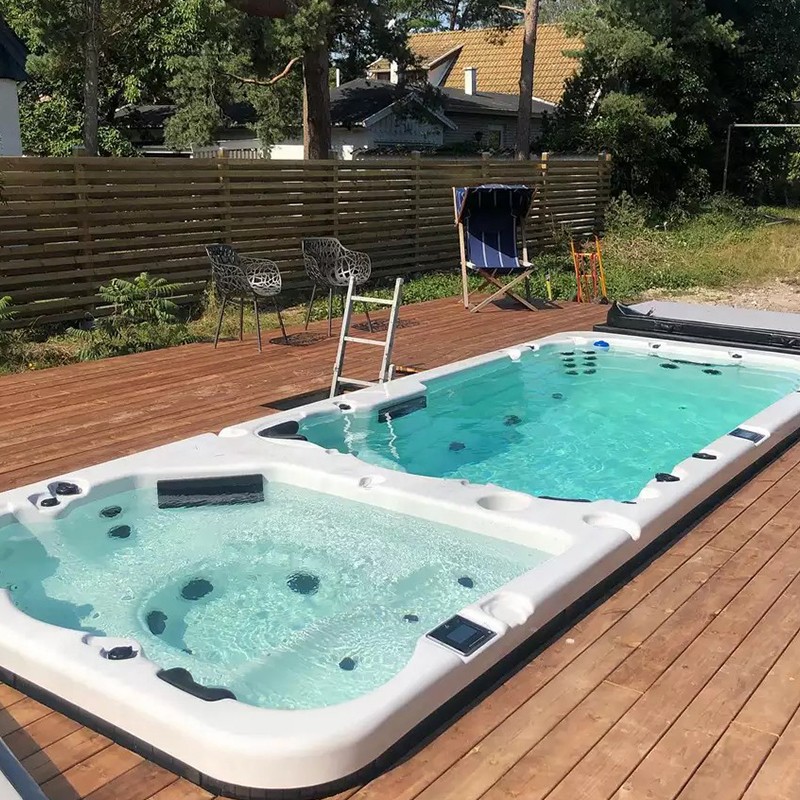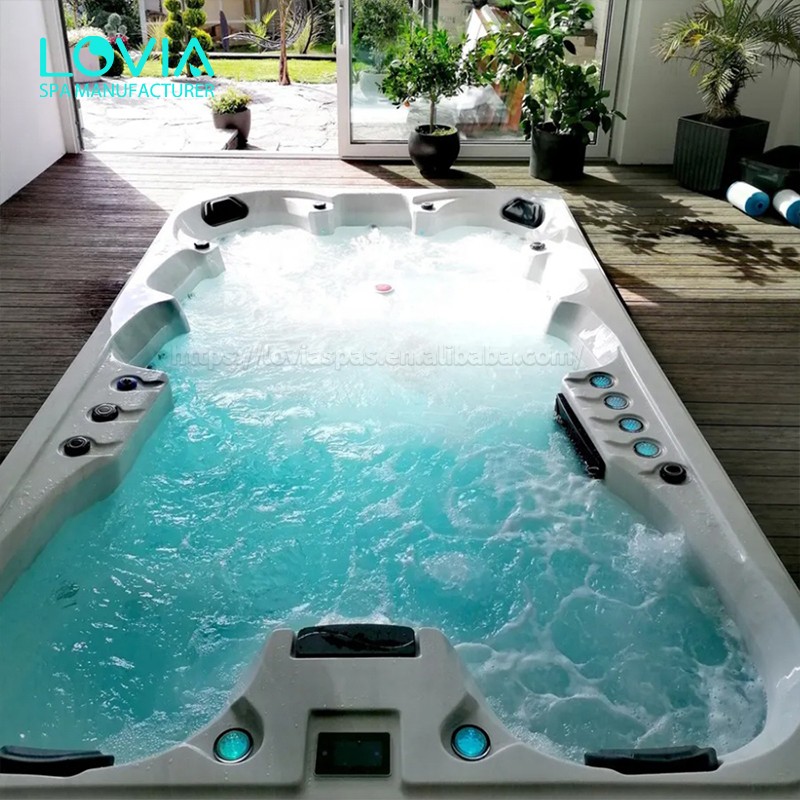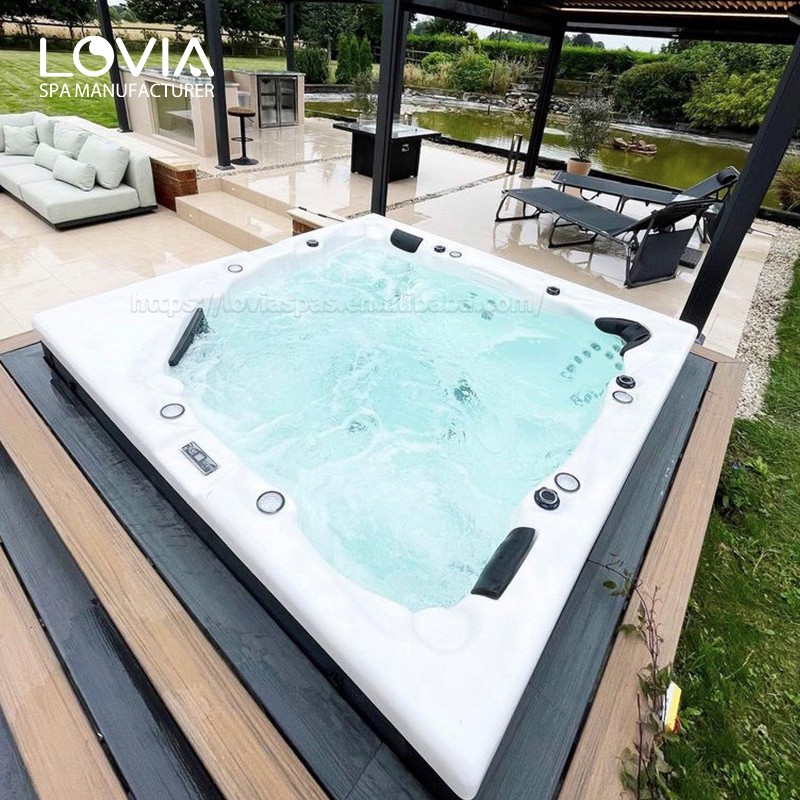
Can a swim spa tub be installed underground?
2025-09-19 15:35Swim spa tubs, devices that combine swimming training and hydrotherapy, have become a common feature in villas, courtyards, and high-end residential complexes due to their compact footprint, comprehensive functionality, and relatively easy maintenance.
When purchasing a swim spa tub, many users ask, "Can a swim spa tub be installed underground?" This question may seem simple, but it actually involves a wide range of specialized knowledge, including structural engineering, civil foundations, plumbing layout, waterproofing and drainage, and maintenance access.
This article will explore the feasibility of underground installation of a swim spa tub in detail, answering this question step by step and highlighting the various conditions and precautions required for underground installation.

Swim spa tub: Structure and Installation Concepts
Before discussing underground installation, it's necessary to fully understand the structure and operating principles of a swim spa tub.
1. What is a swim spa tub?
A swim spa tub is a complex device that combines swimming and massage functions, typically including the following systems:
· Water propulsion system: Provides adjustable swimming resistance through high-speed water flow;
· Massage jet system: Simulates massage movements to relieve muscle tension;
· Heating and thermostat system: Controls water temperature for seasonal use;
· Filtration and sterilization system: Maintains water purity;
· Structural shell: Typically a one-piece acrylic or composite shell, housing various water pipes, electrical wiring, and foam insulation.
2. Introduction to Common Installation Methods
Swim spa tub installation methods are primarily categorized into two types:
· Above-ground installation: The most common method involves placing the entire unit on a concrete floor or metal stand, with plumbing and electrical connections connected to the system through the base of the unit.
· In-ground installation: The entire tub shell is embedded into the ground, with the edges flush with the ground, enhancing both aesthetics and safety.
Because underground installation involves extensive foundation construction and adjustments to supporting facilities, it is far more complex than above-ground installation. Therefore, whether it is feasible and worthwhile requires professional evaluation.

Can swim spa tubs be buried underground?
Technically, swim spa tubs can be installed underground, but only if they meet a series of strict design, construction, and maintenance requirements. This installation method can improve overall aesthetics, spatial integration, and safety (especially for homes with children or elderly residents), but it also presents more engineering challenges.
Swim spa tub: What are the Pros and Cons of underground installation?
Swim spa tub: Advantages of underground installation:
· Uniform aesthetics: The flush-to-the-ground design complements high-end garden designs;
· Reduced risk: Children or pets are protected from falls due to height;
· Space-saving: No protruding structures, maximizing space utilization;
· Good thermal insulation: Covering the ground reduces heat loss.
Disadvantages of underground swim spa tub installation:
· Complex civil engineering work: requires excavation and support structure construction;
· Structural load-bearing issues: Can the foundation withstand the weight of a full bathtub?
· Difficulty in waterproofing: Waterproofing between the pool walls and the ground must be ensured;
· Limited drainage and maintenance space: Maintenance space must be carefully designed in advance;
· Significant cost increase: Both construction and material costs will increase.
In summary, while underground installation offers certain advantages in some environments, it requires rigorous design and construction to ensure feasibility and safety.
Installing an underground swim spa tub: What are the necessary requirements?
To successfully bury a swim spa tub underground, the following five key requirements must be met:
1. Proper Structural Foundation Design
Before installation, the following preparations must be made based on the size and full load weight of the swim spa tub (including water and the weight of the person):
· Excavate the foundation pit, generally 50-80cm larger than the tub's dimensions;
· The concrete base should be at least 15cm thick, with reinforced mesh added if necessary;
· The pool walls should be constructed with brickwork or concrete formwork to prevent backfill from sinking;
· Ensure the foundation is level to avoid tilting, which could lead to uneven water levels and damage to the equipment.
2. Drainage System and Sump Arrangement
Any buried structure must consider:
· The direction of flow during equipment depressurization or water discharge;
· The risk of rainwater backflow;
· The installation of a sump or drain pump to prevent water from accumulating at the bottom of the tub.
It is recommended to design a blind ditch system around the underground structure, combined with a drain pump for forced drainage, to prevent the equipment from being submerged due to rising groundwater levels or accumulated water.
3. Reliable Waterproofing System
Although the above-ground swim spa shell is waterproof, the underground environment is more complex, requiring additional waterproofing measures:
· Use waterproofing membrane or polyurethane coating around the foundation pit;
· Focus on reinforcing joints;
· Joints between the floor and walls should be designed with a counterslope to prevent water backflow.
Two or more waterproof layers should be installed and regularly maintained to prevent damage to the equipment due to water seepage through cracks.
4. Safe Electrical and Plumbing Arrangement
Underground installation of a swim spa places higher demands on the layout of electrical conduits:
· All wiring should be routed through waterproof PVC conduit;
· Switchgear must be located in an accessible area above ground;
· Water pumps, electric heaters, etc. must be equipped with grounding protection and leakage protection devices;
· Maintenance access or inspection shafts should be provided for all pipe connections.
The electrical and plumbing designs should be fully completed and approved on drawings before construction, and reviewed by a professional engineer.
5. Reserve Ventilation and Maintenance Space
When a swim spa is buried, the equipment is partially buried in the soil, making maintenance more complicated. Therefore, it is recommended that:
· Design a removable or openable top cover;
· Provide ground-level access for easy component replacement and debris removal;
· Provide ventilation ducts on the sides of the tub to prevent moisture accumulation and damage to electronic components.

Underground Installation Compatibility of Different Swim Spa Tub Types
Not all swim spa tub types are suitable for underground installation. The following is a compatibility analysis of three common structures:
1. Monolithic Bathtub
Advantages:
· Stable structure, less prone to leaks;
· Simple installation, requiring only water and electricity connections.
Disadvantages:
· Usually external, requiring structural modifications before underground installation;
· Difficult to maintain after underground installation.
Suitable for shallow underground installation, meaning partially buried in the ground.
2. Modular Combination Bathtub
Advantages:
· Easy to transport and install in sections;
· Flexible assembly to suit space.
Disadvantages:
· Multiple connections, requiring high waterproofing requirements;
· Low structural strength compared to monolithic tubs.
Suitable for fully buried installation, requiring strict sealing measures.
3. Customizable Concrete Spa Pools
Advantages:
· Customizable to the underground structure, no additional shell required;
· Strong aesthetic integration with the structure.
Disadvantages:
· Significant engineering effort and high cost;
· Spa functions require separate pumps, nozzles, and other equipment.
Suitable for those seeking a high-end, customized underground spa environment.
Swim Spa Tub: Impact of Underground Installation on Future Use and Maintenance
1. Improved User Experience
· Blending into the landscape for a natural look;
· Convenient access, especially suitable for the elderly and children;
· Surrounding areas can be decorated with plants and lounge chairs for enhanced comfort.
2. Increased Maintenance Challenges
· Increased difficulty locating faults;
· Replacing the pump or electric heater may require partial disassembly of the structure;
· Damaged waterproofing is significantly more difficult to repair than above-ground installations.
Therefore, maintenance space and replacement options must be fully considered during the construction phase.

Are approvals and permits required?
Most areas require a declaration or approval for underground installation of a swim spa tub, especially if:
· The land use in the installation area is changed (e.g., from residential land to recreational use);
· The installation involves structural alterations to a building;
· The installation involves connection to the municipal sewer network.
It is recommended to consult with local construction or municipal authorities during the planning phase to obtain clear guidance and construction permits to avoid legal risks later.
What kind of spa products do you manufacture and supply?
We specialize in producing a wide variety of outdoor hot tubs, spa massage bathtubs, and swimming spas. Our factory is equipped with modern facilities to ensure high-quality manufacturing at competitive prices. As one of the leading manufacturers and suppliers, we cater to wholesale buyers, retailers, and individual customers.
Our product catalog covers luxury spas, family hot tubs, and professional swim spas, all available at low prices with customizable options. Clients who buy directly from us benefit from factory promotions, wholesale sales discounts, and customized purchasing quotes.
